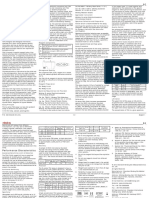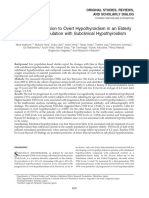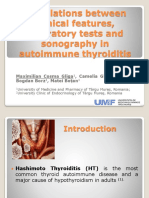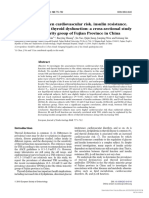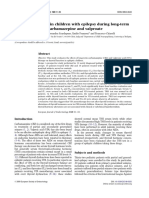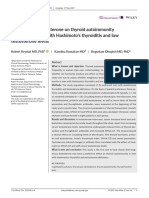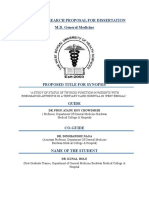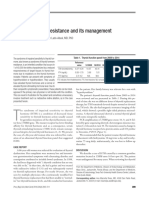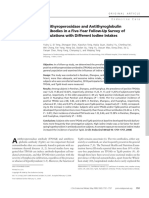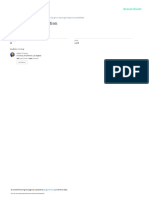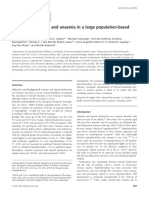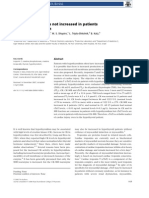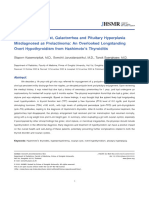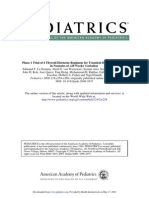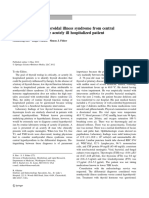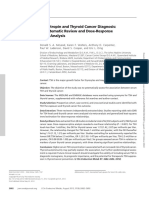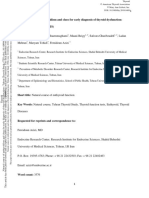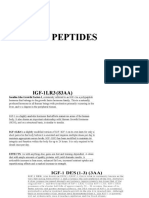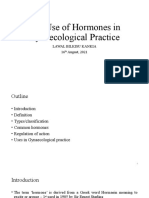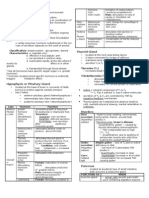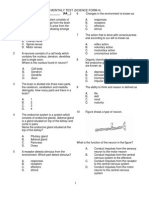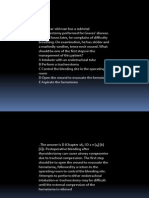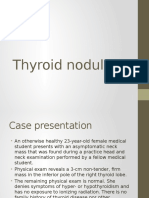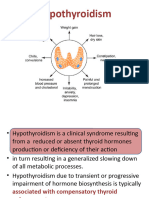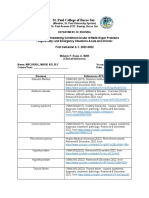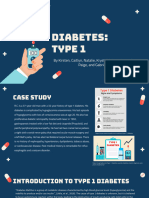Walsh 2010
Walsh 2010
Uploaded by
Javier Burgos CárdenasCopyright:
Available Formats
Walsh 2010
Walsh 2010
Uploaded by
Javier Burgos CárdenasCopyright
Available Formats
Share this document
Did you find this document useful?
Is this content inappropriate?
Copyright:
Available Formats
Walsh 2010
Walsh 2010
Uploaded by
Javier Burgos CárdenasCopyright:
Available Formats
ORIGINAL ARTICLE
E n d o c r i n e C a r e
Thyrotropin and Thyroid Antibodies as Predictors of
Hypothyroidism: A 13-Year, Longitudinal Study of a
Community-Based Cohort Using Current Immunoassay
Techniques
John P. Walsh, Alexandra P. Bremner, Peter Feddema, Peter J. Leedman,
Suzanne J. Brown, and Peter O’Leary
Department of Endocrinology and Diabetes (J.P.W., S.J.B.), Sir Charles Gairdner Hospital, Nedlands, and
Schools of Medicine and Pharmacology (J.P.W., P.J.L.), and Population Health (A.P.B.), University of
Western Australia, Crawley, Western Australia 6009, Australia; Diagnostica Stago (P.F.), Doncaster,
Victoria 3108, Australia; Laboratory for Cancer Medicine (P.J.L.), University of Western Australia Centre
for Medical Research, Western Australian Institute for Medical Research, Perth, Western Australia 6000,
Australia; Department of Endocrinology and Diabetes (P.J.L.), Royal Perth Hospital, Perth, Western
Australia 6847, Australia; Office of Population Health Genomics (P.O.), Western Australian Department
of Health, Perth, Western Australia 6004, Australia; School of Women’s and Infants’ Health and School
of Pathology and Laboratory Medicine (P.O.), University of Western Australia, Crawley, Western
Australia 6009, Australia; and Centre for Population Health Research (P.O.), Curtin Health Innovation
Research Institute, Curtin University of Technology, Bentley, Western Australia 6845, Australia
Context: Longitudinal studies of risk factors for hypothyroidism are required to inform debate
regarding the TSH reference range. There are limited longitudinal data on the predictive value of
thyroid antibodies measured by automated immunoassay (as opposed to semiquantitative
methods).
Methods: We measured TSH, free T4, thyroid peroxidase antibodies (TPOAbs), and thyroglobulin
antibodies (TgAbs) using the Immulite platform on sera from 1184 participants in the 1981 and 1994
Busselton Health Surveys. Outcome measures at follow-up were hypothyroidism, defined as TSH
greater than 4.0 mU/liter or on thyroxine treatment; and overt hypothyroidism, defined as TSH
above 10.0 mU/liter or on thyroxine treatment. Receiver-operator characteristic analysis was used
to determine optimal cutoffs for baseline TSH, TPOAbs, and TgAbs as predictors of hypothyroidism.
Results: At 13 yr follow-up, 110 subjects (84 women) had hypothyroidism, of whom 42 (38 women)
had overt hypothyroidism. Optimal cutoffs for predicting hypothyroidism were baseline TSH above
2.5 mU/liter, TPOAbs above 29 kIU/liter, and TgAbs above 22 kIU/liter, compared with reference
range upper limits of 4.0 mU/liter, 35 kIU/liter, and 55 kIU/liter, respectively. In women with positive
thyroid antibodies (TPOAbs or TgAbs), the prevalence of hypothyroidism at follow-up (with 95%
confidence intervals) was 12.0% (3.0 –21.0%) when baseline TSH was 2.5 mU/liter or less, 55.2%
(37.1–73.3%) for TSH between 2.5 and 4.0 mU/liter, and 85.7% (74.1–97.3%) for TSH above 4.0
mU/liter.
Conclusions: The use of TSH cutoffs of 2.5 and 4.0 mU/liter, combined with thyroid antibodies,
provides a clinically useful estimate of the long-term risk of hypothyroidism. (J Clin Endocrinol
Metab 95: 1095–1104, 2010)
ISSN Print 0021-972X ISSN Online 1945-7197 Abbreviations: NACB, National Academy of Clinical Biochemistry; ROC, receiver-operator
Printed in U.S.A. characteristic; TgAb, thyroglobulin antibody; TPOAb, thyroid peroxidase antibody.
Copyright © 2010 by The Endocrine Society
doi: 10.1210/jc.2009-1977 Received September 21, 2009. Accepted December 4, 2009.
First Published Online January 22, 2010
J Clin Endocrinol Metab, March 2010, 95(3):1095–1104 jcem.endojournals.org 1095
Downloaded from https://academic.oup.com/jcem/article-abstract/95/3/1095/2596745
by guest
on 14 May 2018
1096 Walsh et al. Long-Term Predictors of Hypothyroidism J Clin Endocrinol Metab, March 2010, 95(3):1095–1104
utoimmune hypothyroidism is a common disorder, selton Health Survey in Busselton, Western Australia (6). The
A with a prevalence between 1 and 10%, depending
on the population studied and the definition used (1–3).
majority of subjects participated in a follow-up survey in
1994. Accordingly, we examined risk factors for the presence
The most sensitive diagnostic marker is a raised serum of hypothyroidism at 13 yr follow-up.
TSH concentration, making it essential that the reference
range for TSH is soundly based. Conventionally, this is
based on the 95% confidence interval of log-transformed Subjects and Methods
TSH concentrations from healthy individuals, which in
The Busselton Health Study (http://bsn.uwa.edu.au) includes
iodine-sufficient populations gives an upper limit of ap- cross-sectional health surveys of residents of Busselton, a rural
proximately 4.0 – 4.5 mU/liter (1, 4 – 8). Several author- town in Western Australia with a predominantly white, iodine-
ities believe that the upper limit of the TSH reference sufficient population (21). Detailed descriptions of the surveys
range should be lowered to 2.5 or 3 mU/liter, which have been published previously (22). The Busselton Thyroid
remains controversial (2, 3, 9 –13). The arguments in Study is based on the 1981 and 1994 surveys, in which partici-
pants completed a health questionnaire, underwent physical ex-
favor of this include the increased prevalence of thyroid amination, and gave a venous blood sample in the morning after
antibodies and risk of developing hypothyroidism in an overnight fast. In 2001 archived sera from 2108 participants
people whose TSH concentrations are in the upper part in the 1981 survey were assayed for TSH, free T4, TPOAb, and
of the reference range. TgAb concentrations using an Immulite 2000 chemiluminescent
Clearly longitudinal studies examining the association analyzer (Siemens Healthcare Diagnostics Products, Deerfield,
IL), as previously described (6, 23). Of these 2108 subjects, 1328
between baseline TSH and the development of hypothy-
also attended the 1994 survey and had a blood sample collected.
roidism are crucial to inform this debate, but few have In 2007 archived sera from these subjects were assayed for TSH,
been published. The most influential is the Whickham Sur- free T4, and TPOAb concentrations using the same immunoas-
vey, in which a baseline serum TSH concentration above say platform. All serum samples had been securely stored at ⫺70
2 mU/liter was associated with an increased risk of hypo- C in air-tight polypropylene tubes that were filled to capacity and
had not been thawed during storage. Reference ranges derived
thyroidism at 20 yr follow-up (14). In women who were
from a cross-sectional analysis of the cohort [as previously de-
euthyroid at baseline, positive thyroid antibody status was scribed (6)] were as follows: TSH, 0.4 – 4.0 mU/liter; free T4,
a strong predictor of hypothyroidism, with similar pre- 0.7–1.8 ng/dl (9 –23 pmol/liter); TPOAb, less than 35 kIU/liter;
dictive value to raised TSH at baseline. In the Whickham and TgAb less than 55 kIU/liter. Positive thyroid antibody status
Survey, baseline measurements of TSH were carried out was defined as elevated concentration of either TPOAb or TgAb.
The primary outcome measure (as determined at the 1994
using a first-generation RIA with a reference range of less
visit) was hypothyroidism, defined as serum TSH greater than
than 6 mU/liter (15), which may give higher measured 4.0 mU/liter or on treatment with T4, and the secondary outcome
TSH values than the third-generation immunoassays measure was overt hypothyroidism, defined as serum TSH
now in general use (10, 16, 17). Thyroid antibody status greater than 10.0 mU/liter or on T4 treatment. The rationale for
was based on the detection of antimicrosomal, anticy- this was that an elevated serum TSH concentration is the most
sensitive indicator of hypothyroidism, but the need for routine
toplasmic, and antithyroglobulin antibodies by semi-
T4 replacement for people with mildly elevated TSH concentra-
quantitative methods of red cell agglutination, particle tions up to 10 mU/liter is uncertain (3, 9, 11, 12, 24 –28). We
agglutination, and immunofluorescence. These meth- excluded subjects with the following baseline characteristics:
ods are less sensitive than the quantitative, automated raised serum TSH with low free T4, treatment with T4 or anti-
immunoassays for thyroid peroxidase antibodies (TPOAbs) thyroid drugs, evidence of hyperthyroidism (defined as serum
TSH ⬍0.1 mU/liter) or missing serum TSH value. We also ex-
and thyroglobulin antibodies (TgAbs) now used, and
cluded those with discordant thyroid function test results that
the pathological significance of a mildly raised TPOAb suggested pituitary disease or antibody interference (e.g. in-
or TgAb concentration measured by immunoassay is creased TSH and increased free T4) in either survey and subjects
uncertain (10). on amiodarone or lithium treatment because of the confounding
There is therefore a need for longitudinal studies ex- effects of these drugs on thyroid function. Subjects with mildly
reduced baseline TSH concentrations between 0.1 and 0.4 mU/
amining risk factors for the development of hypothy-
liter were not excluded because the pathological significance of
roidism using current techniques to measure thyroid this is uncertain, and TSH often returns to the reference range on
antibodies and TSH. In a recent study from China, Teng repeat testing (29). Subjects with raised TSH and free T4 within
and colleagues (18 –20) confirmed that TPOAb and the reference range at baseline were not excluded because this too
TgAb concentrations measured by immunoassay were can normalize on repeat testing (29, 30), and we wanted to ex-
amine the predictive value of raised TSH for comparison with the
risk factors for the development of hypothyroidism, but
results of the Whickham Survey.
the follow-up period of 5 yr was relatively short. Baseline characteristics of subjects who participated in the
We previously reported a cross-sectional analysis of the 1994 follow-up study were compared with those of subjects who
prevalence of thyroid disease in participants in the 1981 Bus- died before 1994 and subjects who declined to participate using
Downloaded from https://academic.oup.com/jcem/article-abstract/95/3/1095/2596745
by guest
on 14 May 2018
J Clin Endocrinol Metab, March 2010, 95(3):1095–1104 jcem.endojournals.org 1097
2 tests or t tests. Characteristics of the study cohort at the base-
line and follow-up visits were compared using paired t tests or
McNemar’s tests. We examined each of the following baseline
variables as potential predictors of hypothyroidism using logistic
regression models: age, sex, TSH, parity (defined as number of
live births), body mass index, smoking (never smoked, former
smoker, current smoker), TPOAbs, and TgAbs. Variables con-
sidered in the univariate analyses were entered into multivariate
logistic regression models including TPOAbs and TgAbs as ei-
ther continuous or categorical variables. Variables that were not
significant at the 5% level in either the univariate analyses or the
multivariate models were removed stepwise, with variables that
were significant in the univariate analyses retained for adjustment
purposes. Functional forms of covariates (e.g. TSH2, in case of a
quadratic relationship) and interactions were explored, and TSH2
was included because it significantly improved goodness of fit.
Receiver-operator characteristic (ROC) curves were used to
determine the cutoffs for each of baseline TSH, TPOAbs, and
TgAbs that optimized both sensitivity and specificity as predic-
tors of hypothyroidism and overt hypothyroidism. Univariate
and multivariate logistic regression models were used to examine
the association between TPOAb concentration and outcomes in FIG. 1. Subject disposition scheme showing how the study cohort of
TPOAb-positive subjects using arbitrarily selected, but poten- 1184 subjects was derived. fT4, free T4.
tially clinically relevant, TPOAb concentration cutoffs of 3 times
the upper reference limit (105 kU/liter) and 10 times the reference
participate in the 1994 survey were significantly older
limit (350 kU/liter). Similar methodology was used to explore the
association between TgAb concentration and outcomes using than those who did take part but did not differ signifi-
groups based on TgAb cutoffs of 22 and 55 kIU/liter identified cantly from them in prevalence of self-reported thyroid
from the ROC analysis and our previous cross-sectional analysis disease, thyroid antibody status, or baseline TSH. After
(6) respectively. excluding subjects with raised TSH combined with low
Prevalence estimates (with 95% confidence intervals) for hypo-
free T4 or on T4 treatment at baseline, those with hyper-
thyroidism and overt hypothyroidism at follow-up were deter-
mined for categories of baseline TSH and thyroid antibody status thyroidism, and those with missing data or who breached
and age-adjusted odds ratios calculated using logistic regression other exclusion criteria, the final study sample consisted of
models. Using the optimal TSH cutoff identified from ROC anal- 1184 subjects. The mean time between study visits was
yses, split logistic regression models were used to examine the odds 13.0 yr (range 12.3–14.0).
of hypothyroidism being present at follow-up in subjects with base-
line TSH below and above the 2.5 mU/liter threshold, with further
Outcome measures and predictors of
adjustment for sex, age, and antibody status.
Analyses were conducted using PASW Statistics 17.0.2 (SPSS hypothyroidism
Inc., Chicago, IL) and R version 2.9.1 (R Foundation for Statis- The thyroid status of the 1184 study subjects at the
tical Computing, http://www.R-project.org). Significance was baseline and follow-up visits is summarized in Table 2.
set at 0.05. The study was approved by the Busselton Population The prevalence of positive TPOAbs increased from 11.1%
Medical Research Foundation and the Royal Perth Hospital Eth- in 1981 to 15.1% in 1994 (P ⬍ 0.001, McNemar’s test).
ics Committee.
A change in TPOAb status occurred in 6.5% of subjects:
from negative to positive in 5.2% and from positive to
Results negative in 1.3%. At baseline, 1110 subjects (93.7%) had
serum TSH concentrations between 0.1 and 4.0 mU/liter
Demographics and subject disposition and none were on T4 treatment. At follow-up, 29 subjects
Of the 2108 subjects in the 1981 cross-sectional sam- (2.4%) had commenced T4 treatment and a further 81
ple, 1804 were alive in 1994, and of these 1461 (81%) (6.8%) had elevated serum TSH concentrations, of whom
attended the 1994 survey. A flow chart detailing subject three had low free T4 concentrations. Therefore, 110 sub-
disposition is shown in Fig. 1, and baseline demographic jects (9.3%) including 84 women had hypothyroidism at
data are provided in Table 1. Subjects who died before follow-up (defined as TSH ⬎4 mU/liter or on T4 treat-
1994 tended to be older, were more likely to be male and ment). Of these, 42 subjects (3.5% of the cohort) including
more likely to have smoked than survivors, but did not 38 women had overt hypothyroidism (defined as TSH
differ significantly from survivors in prevalence of self- ⬎10 mU/liter or on T4 treatment).
reported thyroid disease or goiter, thyroid antibody sta- In univariate analyses, the following baseline variables
tus, or baseline TSH. Subjects who were alive but did not were significantly associated with hypothyroidism at fol-
Downloaded from https://academic.oup.com/jcem/article-abstract/95/3/1095/2596745
by guest
on 14 May 2018
1098 Walsh et al. Long-Term Predictors of Hypothyroidism J Clin Endocrinol Metab, March 2010, 95(3):1095–1104
TABLE 1. Baseline characteristics of members of the original 1981 cohort (n ⫽ 2108, categorized by vital status in
1994 and participation or nonparticipation in the 1994 survey) and the 1184 study subjects
Attended Did not attend Deceased
1994 survey 1994 survey in 1994 Study subjects
(n ⴝ 1461) (n ⴝ 343) P valuea (n ⴝ 304) P valueb (n ⴝ 1184)
Age, mean (SD) (yr) 46.2 (14.9) 48.9 (18.5) 0.005 68.7 (10.6) ⬍0.001 45.8 (14.5)
Female, n (%) 747 (51) 177 (52) 0.9 121 (40) ⬍0.001 611 (52)
History of thyroid disease 50 (3.4) 12 (3.5) 0.9 13 (4.3) 0.5 25 (2.1)
or goiter, n (%)
Smoking status, n (%)
Current 275 (19) 76 (22) 0.13 65 (21) ⬍0.001 219 (19)
Former 423 (29) 107 (32) 130 (43) 330 (28)
Never 752 (52) 156 (46) 108 (36) 625 (53)
BMI, mean (SD) (kg/m2) 25.2 (3.8) 26.2 (4.1) ⬍0.001 26.3 (3.9) ⬍0.001 25.2 (3.8)
TSH, median (interquartile 1.42 (0.97–2.03) 1.45 (1.03–2.18) 0.5 1.54 (1.06 –2.26) 1.0 1.43 (0.98 –2.02)
range) (mU/liter)
TPOAb positive, n (%) 180 (12.3) 45 (13.1) 0.7 34 (11.2) 0.6 132 (11.1)
TgAb positive, n (%) 101 (6.9) 18 (5.2) 0.3 16 (5.3) 0.3 76 (6.4)
Thyroid antibody positive 213 (14.6) 50 (14.6) 0.9 35 (1.2) 0.2 158 (13.3)
(TPOAb or TgAb), n (%)
Women only: parity, 2 (0 –9) 2 (0 –10) 0.4 3 (0 –7) 0.9 2 (0 –9)
median (range)
a
P values for comparison between the 1461 subjects who attended the 1994 survey and the 343 subjects who were alive in 1994 but did not
attend.
b
P values for comparison between the 1461 subjects who attended the 1994 survey and the 304 subjects who were deceased in 1994.
low-up: age, gender, TSH, TPOAb concentration, TgAb In multivariate logistic regression models including
concentration, TPOAb-positive status, and TgAb-positive TPOAbs and TgAbs as either continuous or categorical
status, whereas smoking status and parity at baseline were variables, female gender and baseline TSH were the
not significant predictors (Table 3). We also analyzed out- strongest predictors of hypothyroidism, whereas age
comes with regard to parity and smoking status at follow- was not significant (Table 3). The predictive value of
up, age at menopause, and change in weight between base- thyroid antibodies was greatly attenuated in the multi-
line and follow-up visits: none was a significant predictor variate model, with only TgAbs (as a continuous vari-
of hypothyroidism. Of the 76 subjects with positive TgAb, able) remaining significant.
26 were TPOAb negative; of these 4 (15.4%) had hypo-
thyroidism at follow-up, which was not a significantly Optimal cutoffs for TSH, TPOAbs, and TgAbs
increased risk compared with TPOAb-negative, TgAb- Using ROC curve analysis, the baseline TSH cutoff as-
negative subjects (odds ratio 1.80, 95% confidence inter- sociated with the optimal combination of sensitivity and
val 0.52– 4.82). specificity for predicting outcomes was 2.4 mU/liter for
hypothyroidism (sensitivity 76%, specificity 90%) and
2.6 mU/liter for overt hypothyroidism (sensitivity 79%,
TABLE 2. Characteristics of the 1184 study subjects at specificity 90%) (Supplemental Fig. 1 published as sup-
baseline and follow-up plemental data on The Endocrine Society’s Journals On-
Baseline Follow-up line web site at http://jcem.endojournals. org). Results
(n ⴝ 1184) (n ⴝ 1184) were similar for males and females analyzed separately,
Age, mean (SD) (yr) 45.8 (14.5) 58.8 (14.4) with cutoffs for hypothyroidism of 2.6 mU/liter for
TSH, median 1.43 (0.98, 2.02) 1.73 (1.18, 2.51) women (sensitivity 76%, specificity 92%) and 2.3 mU/
(interquartile
liter for men (sensitivity 77%, specificity 88%). On this
range) (mU/liter)
TPOAb positive, n (%) 132 (11.1) 179 (15.1) basis, we selected 2.5 mU/liter as the threshold for further
On T4 treatment 0 (0%) 29 (2.4%) examining outcomes by categories of baseline TSH. The
Not on T4 treatment positive predictive value of a serum TSH concentration
Serum TSH (mU/liter)
Less than 0.4 13 (1.1%) 17 (1.4%) above 2.5 mU/liter at baseline for the presence of hy-
0.4 to 4.0 1110 (93.7%) 1057 (89.3%) pothyroidism at follow-up was 47%, whereas the nega-
4.01–10.0 45 (3.8%) 68 (5.7%) tive predictive value was 97% (Table 4). By contrast, for
Greater than 10.0 16 (1.4%) 13 (1.1%)
baseline TSH above 4 mU/liter (the upper limit of the refer-
Downloaded from https://academic.oup.com/jcem/article-abstract/95/3/1095/2596745
by guest
on 14 May 2018
J Clin Endocrinol Metab, March 2010, 95(3):1095–1104 jcem.endojournals.org 1099
TABLE 3. Results of logistic regression analysis of of 29 kIU/liter to the cohort of 1184 subjects resulted in
potential risk factors at baseline for the presence of reclassification of 12 subjects and only minor changes in
hypothyroidism at follow-up sensitivity and specificity, whereas applying the cutoff of
32 kIU/liter did not reclassify any participant. Accord-
Odds ratio 95% CI P
ingly, we did not reanalyze outcomes using the lower cut-
Univariate analysis
Age (yr) 1.02 1.01, 1.04 0.002
offs. Using logistic regression models, we examined the
Female sex 3.35 2.16, 5.38 ⬍0.001 association between categories of TPOAb concentration
TSH, mU/liter 3.50 2.83, 4.41 ⬍0.001 and outcomes in TPOAb-positive subjects (Table 5). The
BMI (kg/m2) 1.02 0.97, 1.07 0.49
risk of hypothyroidism and overt hypothyroidism in-
Smoking status
Former smoker 0.86 0.55, 1.36 0.52 creased markedly across groups with higher TPOAb
Current smoker 0.59 0.32, 1.07 0.08 concentrations, but the association was greatly attenu-
Parity 0.96 0.83, 1.10 0.15 ated by adjustment for age, sex, and TSH.
TPOAb (kIU/liter) 1.004 1.003, 1.005 ⬍0.001
TgAb (kIU/liter) 1.005 1.003, 1.008 ⬍0.001 For TgAbs, ROC curve analysis (Supplemental Fig. 1)
Antibody status identified an optimal cutoff of 22 kIU/liter for both hy-
TPOAb positive 12.9 8.35, 20.2 ⬍0.001 pothyroidism (49% sensitivity, 84% specificity) and overt
TgAb positive 6.80 4.01, 11.4 ⬍0.001
Multivariate analysis hypothyroidism (63% sensitivity, 83% specificity). This
Age (yr) 1.01 0.99, 1.03 0.40 cutoff differed substantially from the reference range limit
Female sex 2.50 1.39, 4.45 0.002 of 55 kIU/liter derived from the cross-sectional analysis,
TSH (mU/liter) 3.59 2.74, 4.71 ⬍0.001
TSH2 0.98 0.97, 0.99 ⬍0.001 which was associated with 25% sensitivity and 94% spec-
TPOAb (kIU/liter) 1.001 1.000, 1.002 0.12 ificity for hypothyroidism and 24% sensitivity and 94%
TgAb (kIU/liter) 1.003 1.000, 1.005 0.03 specificity for overt hypothyroidism. To explore this fur-
Multivariate analysis
Age (yr) 1.01 0.99, 1.03 0.50 ther, we examined outcomes in groups based on TgAb cut-
Female sex 2.53 1.41, 4.53 0.002 offs of 22 and 55 kIU/liter (Table 5). In unadjusted analyses,
TSH (mU/liter) 3.41 2.58, 4.51 ⬍0.001 the risk of hypothyroidism and overt hypothyroidism was
TSH2 0.98 0.96, 0.99 0.02
TPOAb positive 1.92 0.94, 3.90 0.07 significantly increased in subjects with TgAb concentration
TgAb positive 1.50 0.65, 3.44 0.34 of 22–55 kIU/liter and those with TgAb greater than 55 kIU/
For continuous variables, the odds ratio shown is per unit increase liter, but after adjustment for age, sex, and TSH, neither
in explanatory variable. Smoking status refers to comparison with category was associated with significantly increased risk
never-smokers. CI, Confidence interval; BMI, body mass index. compared with lower values. The small number of subjects
with TgAbs above 55 kIU/liter precluded further analysis of
ence range), the positive predictive value for hypothyroidism
outcomes according to TgAb concentration.
was 84% and the negative predictive value 95%.
For TPOAb, the optimal cutoffs identified by ROC
analysis were 29 kIU/liter for hypothyroidism (sensitivity Risk of hypothyroidism according to gender,
52%, specificity 92%) and 32 kIU/liter for overt hypo- baseline TSH, and antibody status
thyroidism (sensitivity 69%, specificity 90%) (Supple- We used TSH cutoffs of 2.5 and 4.0 mU/liter (derived
mental Fig. 1). These cutoffs were close to the upper limit from the ROC analysis and the reference range, respec-
of the reference range of 35 kIU/liter derived from cross- tively) together with gender and antibody status to ex-
sectional analysis of participants in the 1981 study (6), amine the absolute and relative risks of hypothyroidism
which was associated with 53% sensitivity and 93% spec- in subgroups of subjects (Tables 6 and 7). For men, the
ificity for hypothyroidism and 67% sensitivity and spec- risk of hypothyroidism was very low in subjects with
ificity 91% for overt hypothyroidism. Applying the cutoff baseline TSH of 2.5 mU/liter or less and increased pro-
TABLE 4. Sensitivity, specificity, positive predictive value (PPV), and negative predictive value (NPV) of baseline
serum TSH greater than 2.5 mU/liter or greater than 4 mU/liter for the presence of hypothyroidism and overt
hypothyroidism at follow-up
Baseline serum TSH concentration
Greater than 2.5 mU/liter Greater than 4 mU/liter
Sensitivity Specificity PPV NPV Sensitivity Specificity PPV NPV
(%) (%) (%) (%) (%) (%) (%) (%)
Hypothyroidism 73 91 47 97 45 99 84 95
Overt hypothyroidism 79 88 19 99 64 94 31 99
Downloaded from https://academic.oup.com/jcem/article-abstract/95/3/1095/2596745
by guest
on 14 May 2018
1100 Walsh et al. Long-Term Predictors of Hypothyroidism J Clin Endocrinol Metab, March 2010, 95(3):1095–1104
TABLE 5. Study outcomes analyzed by baseline TPOAb concentration and TgAb concentration
TPOAb concentration (kIU/liter)
<35 35–105 106 –350 >350
(n ⴝ 1052) (n ⴝ 43) (n ⴝ 38) (n ⴝ 51)
Hypothyroidism, n (%) 55 (5.2) 6 (14.0) 16 (42.1) 33 (64.7)
Odds ratio (95% CI)
Unadjusted 1.0 2.9 (1.2–7.3) 13.2 (6.6 –26.5) 33.2 (17.6 – 62.7)
Adjusted for age, sex, TSH, TSH2 1.0 1.1 (0.4 –3.3) 2.1 (0.8 –5.5) 4.3 (1.7–10.9)
Overt hypothyroidism, n (%) 14 (1.3) 2 (4.7) 7 (18.4) 19 (37.3)
Odds ratio (95% CI)
Unadjusted 1.0 3.6 (0.8 –16.4) 16.7 (6.3– 44.4) 44.0 (22.3–95.5)
Adjusted for age, sex, TSH, TSH2 1.0 2.9 (0.6 –13.9) 4.3 (1.2–15.8) 7.5 (2.4 –23.5)
TgAb concentration (kIU/liter)
<22 22–55 >55
(n ⴝ 963) (n ⴝ 145) (n ⴝ 76)
Hypothyroidism, n (%) 57 (5.9) 26 (17.9) 27 (35.5)
Odds ratio (95% CI)
Unadjusted 1.0 3.6 (2.2–5.9) 9.3 (5.4 –16.0)
Adjusted for age, sex, TSH, TSH2 1.0 1.1 (0.5–2.3) 2.1 (1.0 – 4.6)
Overt hypothyroidism 16 (1.7) 16 (11.0) 10 (13.2)
Odds ratio (95% CI)
Unadjusted 1.0 7.2 (3.5–14.7) 9.2 (4.0 –21.2)
Adjusted for age, sex, TSH, TSH2 1.0 2.7 (1.0 –7.1) 1.9 (0.6 – 6.2)
Data are given as number and percentage unless otherwise shown. Reference ranges: TPOAb, less than 35 kIU/liter; TgAb less than 55 kIU/liter. CI,
Confidence interval.
gressively across higher categories of TSH. Of 36 men 55.2% (37.1–73.3%) for TSH between 2.5 and 4.0 mU/liter,
with positive thyroid antibodies and TSH between 0.1 and 85.7% (74.1–97.3%) for baseline TSH above 4.0 mU/
and 4.0 mU/liter, only 2 (5.6%) developed hypothy- liter, suggesting that these TSH cutoffs provided useful risk
roidism, of whom 1 (2.8%) had overt hypothyroidism. stratification.
The small number of men with positive antibodies and Using split regression models, the odds ratio and proba-
outcome measures precluded more detailed analysis. bility for hypothyroidism at 13 yr follow-up was determined
For women, the risk of hypothyroidism was lowest in in all subjects with baseline TSH below or above the 2.5
antibody-negative subjects with baseline TSH of 2.5 mU/liter mU/liter cutoff. The results are shown graphically in Fig. 2.
or less and increased progressively across categories of TSH
and antibody status. In women with positive thyroid anti-
bodies at baseline (defined as TPOAb or TgAb concentration Discussion
above the reference range), the prevalence of hypothyroidism
at follow-up (with 95% confidence intervals) was 12.0% This study provides longitudinal data on risk factors for
(3.0 –21.0%) when baseline TSH was 2.5 mU/liter or less, hypothyroidism over a 13-yr period, using current meth-
TABLE 6. Study outcomes analyzed by categories of baseline TSH for males
TSH (mU/liter)
0.1–2.5 (n ⴝ 514) 2.5– 4.0 (n ⴝ 43) >4.0 (n ⴝ 16) P for trend
Hypothyroidism 10 4 12
1.9% 9.3% 75.0% ⬍0.001
Odds ratioa 1.0 4.9 136
95% CI 1.5, 16.4 36.9, 501
Overt hypothyroidism 1 1 2
0.20% 2.3% 12.5% 0.001
Odds ratioa 1.0 16.1 375
95% CI 0.9, 279 14.7, 9574
Data are shown as number, percentage, and for females, 95% confidence interval (CI) for the percentage (where this could be calculated). P
values are shown for the trend across groups. Positive thyroid antibody status was defined as TPOAb or TgAb concentration above the laboratory
reference range.
a
Adjusted for age.
Downloaded from https://academic.oup.com/jcem/article-abstract/95/3/1095/2596745
by guest
on 14 May 2018
J Clin Endocrinol Metab, March 2010, 95(3):1095–1104 jcem.endojournals.org 1101
ods for measurement of TSH and thyroid antibodies. The
Data are shown as number and percentage, and for females, 95% confidence interval (CI) for the percentage (where this could be calculated). P values are shown for the trend across groups. Positive
results will help inform debate regarding the reference
P for trend
⬍0.001
⬍0.001
range for TSH and provide a tool for clinicians to estimate
the long-term risk of hypothyroidism in patients based on
gender, TSH, and thyroid antibody status.
As expected from previous longitudinal studies (14, 18,
31), age, female gender, thyroid antibodies, and baseline
TSH were associated with hypothyroidism in univariate
(43.8 –76.2)
(74.1–97.3)
antibodies
61.7, 553
37.2, 312
(n ⴝ 35)
positive
85.7%
60.0%
analyses. Smoking was not associated with a significant
>4.0
reduction in the risk of hypothyroidism, in contrast to
30
185
21
108
the results of cross-sectional studies (32–34), but the
TABLE 7. Study outcomes analyzed by categories of baseline TSH and for females further analyzed by thyroid antibody status
number of smokers was small and statistical power ac-
cordingly limited. Parity was not a risk factor for hy-
pothyroidism, consistent with cross-sectional analyses
(41.6 –98.4)
antibodies
16.5, 311
10.8, 229
negative
(n ⴝ 10)
of this and another cohort (35, 36) but in contrast to
70.0%
40.0%
>4.0
71.6
49.7
another study in which parity was associated with au-
7
toimmune thyroiditis (37). In the multivariate analysis,
female gender and TSH were the strongest independent
predictors of hypothyroidism, whereas age was no
longer significant, and thyroid antibodies were of bor-
(37.1–73.3)
antibodies
15.4, 94.2
derline significance.
2.8, 38.1
(n ⴝ 29)
positive
2.5– 4.0
55.2%
13.8%
For baseline TSH, ROC analysis identified a threshold
38.1
10.4
16
of 2.5 mU/liter as associated with optimal sensitivity and
specificity in predicting hypothyroidism. This is broadly
thyroid antibody status was defined as TPOAb or TgAb concentration above the laboratory reference range.
consistent with data from Whickham (14) and China (18 –
20), in which the risk of hypothyroidism was higher if
(14.1– 42.3)
antibodies
baseline TSH was above 2 mU/liter. Based in part on the
negative
5.0, 29.3
0.2, 14.7
(n ⴝ 39)
2.5– 4.0
28.2%
2.6%
Whickham Survey, it has been argued that the upper limit
12.1
1.8
11
of the TSH reference range should be lowered to 2.5 or 3
mU/liter (9 –11, 24). Our study demonstrates that indi-
viduals with serum TSH between 2.5 and 4 mU/liter are
indeed at increased risk of hypothyroidism, but the ma-
jority of such subjects did not develop hypothyroidism by
antibodies
(3.0 –21.0)
1.5, 11.5
0.2, 11.3
(n ⴝ 50)
positive
0.1–2.5
12.0%
2.0%
13 yr follow-up. For this reason, we do not support low-
4.2
1.4
6
ering the upper limit of the TSH reference range to 2.5
mU/liter, but it is certainly reasonable to regard TSH con-
centrations of 2.5– 4 mU/liter as a category of intermediate
risk, especially in women with positive thyroid antibodies.
Follow-up thyroid function testing for such individuals is
antibodies
(n ⴝ 448)
negative
(1.5– 4.7)
(0.4 –2.7)
0.1–2.5
3.1%
1.6%
appropriate, as already recommended (2, 3).
1.0
1.0
In our previous cross-sectional study (6), we derived
14
reference ranges for TPOAbs and TgAbs based on 95%
confidence intervals from 2026 subjects with no history of
thyroid disease. For comparison, we also used the ap-
proach recommended by National Academy of Clinical
Overt hypothyroidism
Biochemistry (NACB) guidelines of deriving these refer-
Hypothyroidism
ence ranges from males aged under 30 yr with serum TSH
Adjusted for age.
between 0.5 and 2.0 mU/liter (10). In the present study, the
Odds ratioa
Odds ratioa
optimal TPOAb cutoffs identified by ROC analysis (29
95% CI
95% CI
kIU/liter for hypothyroidism and 32 kIU/liter for overt
hypothyroidism) were close to the reference range upper
limits derived from the whole cohort (35 kIU/liter) and that
a
Downloaded from https://academic.oup.com/jcem/article-abstract/95/3/1095/2596745
by guest
on 14 May 2018
1102 Walsh et al. Long-Term Predictors of Hypothyroidism J Clin Endocrinol Metab, March 2010, 95(3):1095–1104
lower or upper part of the reference range. For
example, in antibody-positive women with
baseline TSH less than 2.5 mU/liter, the risk of
hypothyroidism was approximately 1% per
year and the risk of overt hypothyroidism
0.2% per year, whereas in antibody-positive
women with baseline TSH between 2.5 and 4.0
mU/liter, the risks were much higher, at 4 and
1% per year, respectively. (This use of annual-
ized estimates of risk may not be strictly valid
because it assumes a constant incidence of hypo-
thyroidism over time, but it is the only practical
way of comparing results from studies with dif-
ferent durations of follow-up.) Our results, as
FIG. 2. Predicted odds of hypothyroidism from a logistic regression model split at a summarized in Tables 6 and 7, will allow clini-
baseline TSH of 2.5 mU/liter (vertical dotted line). For the purposes of illustration,
cians to use patients’ serum TSH and thyroid an-
TSH values were grouped in 50 bins of equal size on the natural logarithmic scale:
F, Antibody positive; E antibody negative; Πactual odds ratios from smoothed raw tibody status to estimate the long-term risk of
data. Dashed lines represent the predicted odds of hypothyroidism for antibody hypothyroidism or overt hypothyroidism, as
positive (upper) and antibody negative (lower) subjects, averaged over other preferred.
covariates. The right-hand axis shows the conversion of odds ratios to the probability
of hypothyroidism. The strengths of our study include its large,
community-based cohort and the long fol-
low-up duration of 13 yr. Our study also has
derived by the NACB-recommended approach (30 kIU/
limitations. First, we were able to study only survivors in
liter). For TPOAb-positive subjects, the risk of hypothyroid-
the cohort and have no information on the ultimate thy-
ism was highest in subjects with the highest TPOAb concen-
roid status of those who died or declined to participate in
trations, whereas mildly elevated TPOAb concentrations of
the 1994 survey. However, the participation rate among
up to 3 times normal had no independent predictive value
survivors was high (81%), and baseline thyroid and thy-
after adjustment for age, sex, and TSH.
roid antibody status did not differ significantly between
For TgAbs, the cutoff of 22 kIU/liter from the ROC
participants and nonparticipants, making this unlikely
analysis differed substantially from the cutoff of 55 kIU/
to be an important source of bias. Second, the definition
liter derived from our cross-sectional analysis and was
of hypothyroidism included physician-prescribed T4 re-
closer to the cutoff of 28 kIU obtained using NACB guide-
placement, and we had no access to serum TSH con-
lines (6). TgAb concentrations between 22 and 55 kIU/
centrations at the time of diagnosis for independent
liter were associated with a greater risk of hypothyroidism
verification.
than lower levels, but this was not significant after adjust-
In conclusion, in this 13-yr longitudinal analysis of a
ment for age, sex, and TSH. If the 22 kIU/liter cutoff were
community-based cohort, female gender and TSH were
adopted as reference range limit, the prevalence of TgAb
the strongest risk factors for the presence of hypothyroid-
positivity in the cohort would increase from 6.4 to 17.3%,
ism at follow-up. The use of TSH cutoffs of 2.5 and 4.0
and the prevalence of positive thyroid antibodies (TPOAbs
mU/liter, combined with thyroid antibodies as measured
or TgAbs) from 13.3 to 21.1%. Unless positive TgAb status
by automated immunoassay, provides a clinically useful
(in the absence of TPOAbs) is shown to be an independent
estimate of the long-term risk of hypothyroidism.
risk factor for hypothyroidism, we do not believe that such
a drastic change to the reference interval is warranted, but
our data suggest that this question warrants further study.
In the Whickham Survey, positive thyroid antibody sta- Acknowledgments
tus in women who were euthyroid at baseline (defined as
serum TSH ⬍6 mU/liter) was a strong predictor of hypo- We thank the Busselton Population Medical Research Founda-
thyroidism at follow-up, with an associated risk of 2.1% tion for approving the study, Graham Maier for data extraction,
John Beilby for assistance with stored sera, and Valdo Michel-
per year (14). It is difficult to compare our results with
angeli for his major contribution in the establishment of the
those because of differences in assay methods, TSH ref-
Busselton Thyroid Study.
erence range, and follow-up duration. We found, how-
ever, that useful risk stratification is achieved by examin- Address all correspondence and requests for reprints to: Clin
ing outcomes according to whether baseline TSH is in the A/Professor John P. Walsh, Department of Endocrinology and
Downloaded from https://academic.oup.com/jcem/article-abstract/95/3/1095/2596745
by guest
on 14 May 2018
J Clin Endocrinol Metab, March 2010, 95(3):1095–1104 jcem.endojournals.org 1103
Diabetes, Sir Charles Gairdner Hospital, Nedlands, Western thyroid disease in a community: the Whickham survey. Clin Endo-
Australia 6009. E-mail: john.walsh@health.wa.gov.au. crinol (Oxf) 7:481– 493
Disclosure Summary: The authors have no disclosures. 16. Pekary AE, Hershman JM 1984 A new monoclonal-antibody two-
site solid-phase immunoradiometric assay for human thyrotropin
evaluated. Clin Chem 30:1213–1215
17. Nicoloff JT, Spencer CA 1990 The use and misuse of the sensitive
References thyrotropin assays. J Clin Endocrinol Metab 71:553–558
18. Teng W, Shan Z, Teng X, Guan H, Li Y, Teng D, Jin Y, Yu X, Fan
1. Hollowell JG, Staehling NW, Flanders WD, Hannon WH, Gunter C, Chong W, Yang F, Dai H, Yu Y, Li J, Chen Y, Zhao D, Shi X, Hu
EW, Spencer CA, Braverman LE 2002 Serum TSH, T(4), and thyroid F, Mao J, Gu X, Yang R, Tong Y, Wang W, Gao T, Li C 2006 Effect
antibodies in the United States population (1988 to 1994): National of iodine intake on thyroid diseases in China. N Engl J Med 354:
Health and Nutrition Examination Survey (NHANES III). J Clin 2783–2793
Endocrinol Metab 87:489 – 499 19. Guan H, Shan Z, Teng X, Li Y, Teng D, Jin Y, Yu X, Fan C, Chong
2. Roberts CG, Ladenson PW 2004. Hypothyroidism. Lancet 363: W, Yang F, Dai H, Yu Y, Li J, Chen Y, Zhao D, Shi X, Hu F, Mao
793– 803 J, Gu X, Yang R, Chen W, Tong Y, Wang W, Gao T, Li C, Teng W
3. Biondi B, Cooper DS 2008 The clinical significance of subclinical 2008 Influence of iodine on the reference interval of TSH and the
thyroid dysfunction. Endocr Rev 29:76 –131 optimal interval of TSH: results of a follow-up study in areas with
4. Bjoro T, Holmen J, Krüger O, Midthjell K, Hunstad K, Schreiner T, different iodine intakes. Clin Endocrinol (Oxf) 69:136 –141
Sandnes L, Brochmann H 2000 Prevalence of thyroid disease, thy- 20. Li Y, Teng D, Shan Z, Teng X, Guan H, Yu X, Fan C, Chong W,
roid dysfunction and thyroid peroxidase antibodies in a large, un- Yang F, Dai H, Gu X, Yu Y, Mao J, Zhao D, Li J, Chen Y, Yang R,
selected population. The Health Study of Nord-Trondelag (HUNT). Li C, Teng W 2008 Antithyroperoxidase and antithyroglobulin an-
Eur J Endocrinol 143:639 – 647 tibodies in a five-year follow-up survey of populations with different
5. Jensen E, Hyltoft Petersen P, Blaabjerg O, Hansen PS, Brix TH, iodine intakes. J Clin Endocrinol Metab 93:1751–1757
Kyvik KO, Hegedüs L 2004 Establishment of a serum thyroid stim- 21. Li M, Eastman CJ, Waite KV, Ma G, Zacharin MR, Topliss DJ,
ulating hormone (TSH) reference interval in healthy adults. The Harding PE, Walsh JP, Ward LC, Mortimer RH, Mackenzie EJ,
importance of environmental factors, including thyroid antibodies. Byth K, Doyle Z 2006 Are Australian children iodine deficient?
Clin Chem Lab Med 42:824 – 832 Results of the Australian National Iodine Nutrition Study. Med J
6. O’Leary PC, Feddema PH, Michelangeli VP, Leedman PJ, Chew GT, Aust 184:165–169
Knuiman M, Kaye J, Walsh JP 2006 Investigations of thyroid hor- 22. Knuiman MW, Jamrozik K, Welborn TA, Bulsara MK, Divitini ML,
mones and antibodies based on a community health survey: the Whittall DE 1995 Age and secular trends in risk factors for cardio-
Busselton thyroid study. Clin Endocrinol (Oxf) 64:97–104 vascular disease in Busselton. Aust J Public Health 19:375–382
7. Kratzsch J, Fiedler GM, Leichtle A, Brüugel M, Buchbinder S, Otto 23. Walsh JP, Bremner AP, Bulsara MK, O’Leary P, Leedman PJ,
L, Sabri O, Matthes G, Thiery J 2005 New reference intervals for Feddema P, Michelangeli V 2005 Subclinical thyroid dysfunction as a
thyrotropin and thyroid hormones based on National Academy of risk factor for cardiovascular disease. Arch Intern Med 165:2467–2472
Clinical Biochemistry criteria and regular ultrasonography of the 24. McDermott MT, Ridgway EC 2001 Subclinical hypothyroidism is
thyroid. Clin Chem 51:1480 –1486 mild thyroid failure and should be treated. J Clin Endocrinol Metab
8. Hamilton TE, Davis S, Onstad L, Kopecky KJ 2008 Thyrotropin 86:4585– 4590
levels in a population with no clinical, autoantibody, or ultra- 25. Chu JW, Crapo LM 2001 The treatment of subclinical hypothyroidism
sonographic evidence of thyroid disease: implications for the di- is seldom necessary. J Clin Endocrinol Metab 86:4591– 4599
agnosis of subclinical hypothyroidism. J Clin Endocrinol Metab 26. Surks MI, Ortiz E, Daniels GH, Sawin CT, Col NF, Cobin RH,
93:1224 –1230 Franklyn JA, Hershman JM, Burman KD, Denke MA, Gorman C,
9. Baskin HJ, Cobin RH, Duick DS, Gharib H, Guttler RB, Kaplan Cooper RS, Weissman NJ 2004 Subclinical thyroid disease: scien-
MM, Segal RL 2002 American Association of Clinical Endocrinol- tific review and guidelines for diagnosis and management. JAMA
ogists medical guidelines for clinical practice for the evaluation and 291:228 –238
treatment of hyperthyroidism and hypothyroidism. Endocr Pract 27. Helfand M 2004 U.S. Preventive Services Task Force screening for
8:457– 469 subclinical thyroid dysfunction in nonpregnant adults: a summary
10. Baloch Z, Carayon P, Conte-Devolx B, Demers LM, Feldt-Rasmussen of the evidence for the U.S. Preventive Services Task Force. Ann
U, Henry JF, LiVosli VA, Niccoli-Sire P, John R, Ruf J, Smyth PP, Intern Med 140:128 –141
Spencer CA, Stockigt JR 2003 Guidelines Committee, National 28. Gharib H, Tuttle RM, Baskin HJ, Fish LH, Singer PA, McDermott
Academy of Clinical Biochemistry Laboratory medicine practice MT 2005 Consensus statement #1: subclinical thyroid dysfunc-
guidelines. Laboratory support for the diagnosis and monitoring of tion: a joint statement on management from the American Asso-
thyroid disease. Thyroid 13:3–126 ciation of Clinical Endocrinologists, the American Thyroid As-
11. Wartofsky L, Dickey RA 2005 The evidence for a narrower thyro- sociation, and The Endocrine Society. J Clin Endocrinol Metab
tropin reference range is compelling. J Clin Endocrinol Metab 90: 90:581–585; discussion 586 –587
5483–5488 29. Meyerovitch J, Rotman-Pikielny P, Sherf M, Battat E, Levy Y, Surks
12. Surks MI, Goswami G, Daniels GH 2005 The thyrotropin refer- MI 2007 Serum thyrotropin measurements in the community: five-
ence range should remain unchanged. J Clin Endocrinol Metab year follow-up in a large network of primary care physicians. Arch
90:5489 –5496 Intern Med 167:1533–1538
13. Brabant G, Beck-Peccoz P, Jarzab B, Laurberg P, Orgiazzi J, Szabolcs 30. Díez JJ, Iglesias P, Burman KD 2005 Spontaneous normalization of
I, Weetman AP, Wiersinga WM 2006 Is there a need to redefine the thyrotropin concentrations in patients with subclinical hypothy-
upper normal limit of TSH? Eur J Endocrinol 154:633– 637 roidism. J Clin Endocrinol Metab 90:4124 – 4127
14. Vanderpump MP, Tunbridge WM, French JM, Appleton D, Bates 31. Geul KW, van Sluisveld IL, Grobbee DE, Docter R, de Bruyn AM,
D, Clark F, Grimley Evans J, Hasan DM, Rodgers H, Tunbridge F, Hooykaas H, van der Merwe JP, van Hemert AM, Krenning EP,
Young ET 1995 The incidence of thyroid disease in the community: Hennemann G 1993 The importance of thyroid microsomal antibodies
a twenty-year follow-up of the Whickham Survey. Clin Endocrinol in the development of elevated serum TSH in middle-aged women:
(Oxf) 43:55– 68 associations with serum lipids. Clin Endocrinol (Oxf) 39:275–280
15. TunbridgeWM, Evered DC, Hall R, Appleton D, Brewis M, Clark 32. Belin RM, Astor BC, Powe NR, Ladenson PW 2004 Smoke expo-
F, Evans JG, Young E, Bird T, Smith PA 1977 The spectrum of sure is associated with a lower prevalence of serum thyroid auto-
Downloaded from https://academic.oup.com/jcem/article-abstract/95/3/1095/2596745
by guest
on 14 May 2018
1104 Walsh et al. Long-Term Predictors of Hypothyroidism J Clin Endocrinol Metab, March 2010, 95(3):1095–1104
antibodies and thyrotropin concentration elevation and a higher 35. Walsh JP, Bremner AP, Bulsara MK, O’Leary P, Leedman PJ,
prevalence of mild thyrotropin concentration suppression in the Feddema P, Michelangeli V 2005 Parity and the risk of autoimmune
third National Health and Nutrition Examination Survey thyroid disease: a community-based study. J Clin Endocrinol Metab
(NHANES III). J Clin Endocrinol Metab 89:6077– 6086 90:5309 –5312
33. Asvold BO, Bjøro T, Nilsen TI, Vatten LJ 2007 Tobacco smoking 36. Bülow Pedersen I, Laurberg P, Knudsen N, Jørgensen T, Perrild H,
and thyroid function: a population-based study. Arch Intern Med Ovesen L, Rasmussen LB 2006 Lack of association between thyroid
167:1428 –1432 autoantibodies and parity in a population study argues against mi-
34. Pedersen IB, Laurberg P, Knudsen N, Jørgensen T, Perrild H, crochimerism as a trigger of thyroid autoimmunity. Eur J Endocrinol
Ovesen L, Rasmussen LB 2008 Smoking is negatively associated 154:39 – 45
with the presence of thyroglobulin autoantibody and to a lesser 37. Friedrich N, Schwarz S, Thonack J, John U, Wallaschofski H, Völzke
degree with thyroid peroxidase autoantibody in serum: a population H 2008 Association between parity and autoimmune thyroiditis in a
study. Eur J Endocrinol 158:367–373 general female population. Autoimmunity 41:174 –180
Downloaded from https://academic.oup.com/jcem/article-abstract/95/3/1095/2596745
by guest
on 14 May 2018
You might also like
- NEW - Optimal Lab GuideDocument22 pagesNEW - Optimal Lab GuideRamsha YasirNo ratings yet
- H-046-003249-00 TSH (CLIA) English MindrayDocument2 pagesH-046-003249-00 TSH (CLIA) English MindrayТатьяна ИсаеваNo ratings yet
- Risk For Progression To Overt Hypothyroidism in An Elderly Japanese Population With Subclinical HypothyroidismDocument6 pagesRisk For Progression To Overt Hypothyroidism in An Elderly Japanese Population With Subclinical HypothyroidismJavier Burgos CárdenasNo ratings yet
- Historia Natural Del Hipotiroidismo SubclinicoDocument4 pagesHistoria Natural Del Hipotiroidismo SubclinicoJoseAbdalaNo ratings yet
- (TC) - 99m Thyroid Scintigraphy in Congenital Hypothyroidism Screening ProgramDocument5 pages(TC) - 99m Thyroid Scintigraphy in Congenital Hypothyroidism Screening ProgramMeutia sariNo ratings yet
- Correlations in Hashimoto ThyroiditisDocument20 pagesCorrelations in Hashimoto ThyroiditisMaximilian GligaNo ratings yet
- Determination of Pediatric Reference Levels of Ft3, Ft4 and TSH Measured With Eclusys KitsDocument6 pagesDetermination of Pediatric Reference Levels of Ft3, Ft4 and TSH Measured With Eclusys KitsIan ChoongNo ratings yet
- Screening Tests For Thyroid Dysfunction Is TSH SufficientDocument12 pagesScreening Tests For Thyroid Dysfunction Is TSH SufficientGlobal Research and Development ServicesNo ratings yet
- Testing For HypothyroidismDocument23 pagesTesting For HypothyroidismFlávia UchôaNo ratings yet
- brmedj01547-0041Document6 pagesbrmedj01547-0041داریوش بستامNo ratings yet
- B-Cell Function and Thyroid Dysfunction: A Cross-Sectional StudyDocument8 pagesB-Cell Function and Thyroid Dysfunction: A Cross-Sectional StudyAbdi KebedeNo ratings yet
- Subclinical Hyperthyroidism: To Treat or Not To Treat?: Best PracticeDocument5 pagesSubclinical Hyperthyroidism: To Treat or Not To Treat?: Best PracticeRaka MahasaduNo ratings yet
- An Analytical Study of Thyroid Hormones in Different Temperaments (Mizaj)Document7 pagesAn Analytical Study of Thyroid Hormones in Different Temperaments (Mizaj)yusufNo ratings yet
- Thyroid Hormones in Children With Epilepsy During Long-Term Administration of Carbamazepine and ValproateDocument6 pagesThyroid Hormones in Children With Epilepsy During Long-Term Administration of Carbamazepine and ValproateJessica Sugiharto DududNo ratings yet
- Wilke 2018Document20 pagesWilke 2018Engenharia LoctradNo ratings yet
- 2020 Effect of L-Thyroxine Administration Before Breakfast Vs at Bedtime On Hypothyroidism: A Meta-AnalysisDocument7 pages2020 Effect of L-Thyroxine Administration Before Breakfast Vs at Bedtime On Hypothyroidism: A Meta-AnalysisNanny Natalia Mulyani SoetedjoNo ratings yet
- The Effect of Testosterone On Thyroid Autoimmunity in Euthyroid Men With Hashimoto's Thyroiditis and Low Testosterone LevelsDocument8 pagesThe Effect of Testosterone On Thyroid Autoimmunity in Euthyroid Men With Hashimoto's Thyroiditis and Low Testosterone LevelsdeboratomeNo ratings yet
- Rawalpindi Army Hosp HypothyDocument5 pagesRawalpindi Army Hosp Hypothyhinduja reddipilliNo ratings yet
- Synopsis KunalDocument17 pagesSynopsis Kunalsambit mondalNo ratings yet
- RTH 1Document3 pagesRTH 1Ei DrakorNo ratings yet
- A Positive Newborn Screen For Congenital Hypothyroidism in A Clinically Euthyroid Neonate - Avoiding Unnecessary TreatmentDocument6 pagesA Positive Newborn Screen For Congenital Hypothyroidism in A Clinically Euthyroid Neonate - Avoiding Unnecessary TreatmentgistaluvikaNo ratings yet
- Antithyroperoxidase and Antithyroglobuli PDFDocument7 pagesAntithyroperoxidase and Antithyroglobuli PDFesassoNo ratings yet
- Fitzgerald Et Al 2020 Clinical Parameters Are More Likely To Be Associated With Thyroid Hormone Levels Than WithDocument15 pagesFitzgerald Et Al 2020 Clinical Parameters Are More Likely To Be Associated With Thyroid Hormone Levels Than WithLesly LoachamínNo ratings yet
- Boelaert2006 PDFDocument7 pagesBoelaert2006 PDFgustianto hutama pNo ratings yet
- Meng Reli 2010Document8 pagesMeng Reli 2010abbhyasa5206No ratings yet
- Hipotiroidismo Congenito Permanente y Transitorio in RNPT Abril 2012Document4 pagesHipotiroidismo Congenito Permanente y Transitorio in RNPT Abril 2012John Hagler Romero AbrilNo ratings yet
- Yadav NK, Thanpari C, Shrewastwa MK, Mittal RK, Koner BCDocument4 pagesYadav NK, Thanpari C, Shrewastwa MK, Mittal RK, Koner BCTorreus AdhikariNo ratings yet
- Revalence of Thyroid Disorders in A Tertiary Care CenterDocument5 pagesRevalence of Thyroid Disorders in A Tertiary Care CenterAvisa Cetta CresmaNo ratings yet
- SC HyperDocument8 pagesSC HyperktyhekNo ratings yet
- GRADES of HypothyroidismDocument6 pagesGRADES of HypothyroidismorthopaedicdepttNo ratings yet
- Thyroid Function and The Metabolic Syndrome in Older Persons: A Population-Based StudyDocument7 pagesThyroid Function and The Metabolic Syndrome in Older Persons: A Population-Based StudyAlifia RahmaNo ratings yet
- Approach To The Patient With Raised Thyroid Hormones and Nonsuppressed TSHDocument15 pagesApproach To The Patient With Raised Thyroid Hormones and Nonsuppressed TSHnicoosportNo ratings yet
- Thyroid Dysfunction and Anaemia in A Large Population-Based StudyDocument5 pagesThyroid Dysfunction and Anaemia in A Large Population-Based StudyRaissa Metasari TantoNo ratings yet
- A Study On Thyroid Function Test in Children With Nephrotic SyndromeDocument3 pagesA Study On Thyroid Function Test in Children With Nephrotic Syndromeamallia_nsNo ratings yet
- Etiological Evaluation of Primary Congenital Hypothyroidism CasesDocument7 pagesEtiological Evaluation of Primary Congenital Hypothyroidism CasesEgidiaEkaRikaNo ratings yet
- Hipotiroidismo SubclinicoDocument7 pagesHipotiroidismo SubclinicoJoseAbdalaNo ratings yet
- 2359 3997 Aem 2359 3997000000189Document7 pages2359 3997 Aem 2359 3997000000189Lucas VibiamNo ratings yet
- Neonatal Screening For Congenital Hypothyroidism Based On Thyroxine, Thyrotropin, and Thyroxine-Binding Globulin Measurement: Potentials and PitfallsDocument7 pagesNeonatal Screening For Congenital Hypothyroidism Based On Thyroxine, Thyrotropin, and Thyroxine-Binding Globulin Measurement: Potentials and PitfallsVaiaNo ratings yet
- David Zurakowski, James Di Canzio, and Joseph A. MajzoubDocument5 pagesDavid Zurakowski, James Di Canzio, and Joseph A. MajzoubChaitanya Kumar ChaituNo ratings yet
- 1 PBDocument6 pages1 PBpelinNo ratings yet
- dgae528Document8 pagesdgae528S VaniiissaNo ratings yet
- (1479683X - European Journal of Endocrinology) DIAGNOSIS of ENDOCRINE DISEASE - How Reliable Are Free Thyroid and Total T3 Hormone AssaysDocument9 pages(1479683X - European Journal of Endocrinology) DIAGNOSIS of ENDOCRINE DISEASE - How Reliable Are Free Thyroid and Total T3 Hormone AssaysRaza MuhammadNo ratings yet
- Karthik S Thesis 3Document34 pagesKarthik S Thesis 3kalyanpavuralaNo ratings yet
- PSAT327 Can Cannabis Use Lead To Central HypothyroDocument1 pagePSAT327 Can Cannabis Use Lead To Central HypothyroDARIO BIDESNo ratings yet
- 4 - Subclinical HypothyroidismDocument10 pages4 - Subclinical HypothyroidismAlejandra RNo ratings yet
- Seite 725-736 #110706-Ketelslegers-1Document13 pagesSeite 725-736 #110706-Ketelslegers-1vophigiabao3No ratings yet
- ESTIMULACION RHTSH EN CANINOS PARA HIPOTIROIDISMODocument8 pagesESTIMULACION RHTSH EN CANINOS PARA HIPOTIROIDISMOMónicaAndreaBarreraNo ratings yet
- Etj 0003 0076Document19 pagesEtj 0003 0076ayssa witjaksonoNo ratings yet
- Intraplatelet Serotonin in Patients With Diabetes Mellitus and Peripheral Vascular DiseaseDocument6 pagesIntraplatelet Serotonin in Patients With Diabetes Mellitus and Peripheral Vascular DiseaseHyeon DaNo ratings yet
- A Prospective Study of Thyroid Function Test in Geriatric Population and Its Clinical Correlation in A Tertiary Teaching Care CenterDocument4 pagesA Prospective Study of Thyroid Function Test in Geriatric Population and Its Clinical Correlation in A Tertiary Teaching Care CenterLindia PrabhaswariNo ratings yet
- Guidelines For TSH-receptor Antibody Measurements in Pregnancy: Results of An Evidence-Based Symposium Organized by The European Thyroid AssociationDocument4 pagesGuidelines For TSH-receptor Antibody Measurements in Pregnancy: Results of An Evidence-Based Symposium Organized by The European Thyroid AssociationZoel NikonianNo ratings yet
- Complementary and Alternative Medical Lab Testing Part 12: NeurologyFrom EverandComplementary and Alternative Medical Lab Testing Part 12: NeurologyNo ratings yet
- 10 A. Neutrophil-And Platelet-To Lymphocyte Ratio in Patients With Euthyroid Hashimoto's Thyroiditis. Exp Clin Endocrinol DiabetesDocument5 pages10 A. Neutrophil-And Platelet-To Lymphocyte Ratio in Patients With Euthyroid Hashimoto's Thyroiditis. Exp Clin Endocrinol DiabetesBridia BogarNo ratings yet
- International Journal of Chemtech Research: Janani Panneer Selvam, Sethu GunasekaranDocument11 pagesInternational Journal of Chemtech Research: Janani Panneer Selvam, Sethu GunasekaranVishnu04No ratings yet
- Cardiac Troponin T Is Not Increased in PatientsDocument5 pagesCardiac Troponin T Is Not Increased in PatientsAnanda Putri ImsezNo ratings yet
- Prevalence of Insulin Resistance and Identifying HOMA1 IR and HOMA2Document16 pagesPrevalence of Insulin Resistance and Identifying HOMA1 IR and HOMA2Othman LaithNo ratings yet
- 10.1515@jpem 2018 0516Document8 pages10.1515@jpem 2018 0516pelinNo ratings yet
- 1033 FgsDocument6 pages1033 Fgssubrata dasNo ratings yet
- 10 4274@jcrpe 845Document6 pages10 4274@jcrpe 845Muhammed AlthafNo ratings yet
- In Neonates of 28 Weeks' Gestation Phase 1 Trial of 4 Thyroid Hormone Regimens For Transient HypothyroxinemiaDocument13 pagesIn Neonates of 28 Weeks' Gestation Phase 1 Trial of 4 Thyroid Hormone Regimens For Transient Hypothyroxinemiaapi-28255451No ratings yet
- Bao 2012Document3 pagesBao 2012Salim MichaelNo ratings yet
- 2.tyroporin and ThyroidDocument11 pages2.tyroporin and ThyroidAccounting CV BakerNo ratings yet
- Page 1 of 27Document27 pagesPage 1 of 27Javier Burgos CárdenasNo ratings yet
- Chapter 47Document19 pagesChapter 47Javier Burgos CárdenasNo ratings yet
- Bjo08800333 PDFDocument3 pagesBjo08800333 PDFJavier Burgos CárdenasNo ratings yet
- Artículo Oftalmología RetinaDocument1 pageArtículo Oftalmología RetinaJavier Burgos CárdenasNo ratings yet
- PeptidesDocument19 pagesPeptidesNate Harding100% (1)
- The Use of Hormones in Gynaecological PracticeDocument24 pagesThe Use of Hormones in Gynaecological PracticeMuhammad AmeenNo ratings yet
- M2 Lesson 3 Endocrine System Animals and PlantsDocument35 pagesM2 Lesson 3 Endocrine System Animals and PlantsSophia Grace VicenteNo ratings yet
- Premenstrual Syndrome 2Document25 pagesPremenstrual Syndrome 2anojan100% (1)
- Rev - Control and CoordinationDocument5 pagesRev - Control and CoordinationAtharv SoniNo ratings yet
- Exercise The Growth Hormone-Insulin-Like Growth Factor-L AxisDocument2 pagesExercise The Growth Hormone-Insulin-Like Growth Factor-L Axisok okNo ratings yet
- Hormonal Control of Human Reproduction: Female: Hormone Source FunctionDocument3 pagesHormonal Control of Human Reproduction: Female: Hormone Source FunctionYen AduanaNo ratings yet
- Master Nilai Mapel Ips Kelas 7 Sem GenapDocument5 pagesMaster Nilai Mapel Ips Kelas 7 Sem GenapAlbert LiwaNo ratings yet
- IsjsjsDocument13 pagesIsjsjsMarsh MallowNo ratings yet
- Physiology of LactationDocument29 pagesPhysiology of Lactationcorzpun16867880% (15)
- Hemorragic CystDocument14 pagesHemorragic CystNyoman TapayanaNo ratings yet
- Hormones TableDocument84 pagesHormones TableSaajid AmraNo ratings yet
- Vog QDocument62 pagesVog QDeep PatelNo ratings yet
- SSLC Science 5 Model Question Papers English MediumDocument41 pagesSSLC Science 5 Model Question Papers English MediumGobinath DhanaNo ratings yet
- HIpertensiDocument28 pagesHIpertensiasna tuppangNo ratings yet
- Endocrine System Anatomy and Physiology - NurseslabsDocument29 pagesEndocrine System Anatomy and Physiology - NurseslabsAlyssum Marie50% (2)
- UNIT13 CompressedDocument27 pagesUNIT13 Compressedemerald CasinilloNo ratings yet
- Endocrine SystemDocument2 pagesEndocrine SystemHerlene Suelto Tingle100% (1)
- Science Form 4 (Monthly Test)Document3 pagesScience Form 4 (Monthly Test)ma'ein100% (1)
- Presentation 7Document14 pagesPresentation 7Nessreen JamalNo ratings yet
- MIDTERM Pilar College Anatomy Physiology Final EditDocument41 pagesMIDTERM Pilar College Anatomy Physiology Final EditYeona BaeNo ratings yet
- List of DrugsDocument6 pagesList of DrugsAli HassanNo ratings yet
- Nodul Tiroidian Engleza PPT 2016Document36 pagesNodul Tiroidian Engleza PPT 2016Stefi GrNo ratings yet
- HypothyroidismDocument60 pagesHypothyroidismmarselia23No ratings yet
- Kidney: ParastationDocument31 pagesKidney: ParastationErin HillNo ratings yet
- NCM 118 ReferencesDocument2 pagesNCM 118 ReferencesMarie Kelsey Acena MacaraigNo ratings yet
- Bullous Pemphigoid Vs Epydermolysis Bullosa Acquisita: Diagnosis and How To DifferentiateDocument12 pagesBullous Pemphigoid Vs Epydermolysis Bullosa Acquisita: Diagnosis and How To DifferentiateIrene Irene100% (1)
- Cdho Assignment 2 Type 1 DiabetesDocument10 pagesCdho Assignment 2 Type 1 Diabetesapi-596913754No ratings yet

